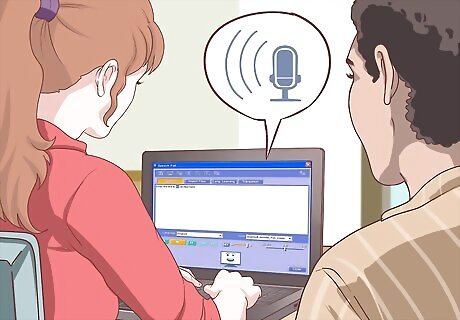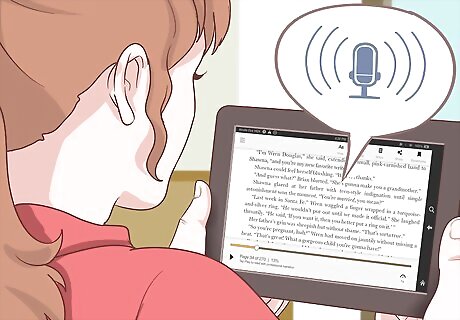
views
X
Trustworthy Source
National Health Service (UK)
Public healthcare system of the UK
Go to source
Dyslexic children become dyslexic adults. Some of the supports that help children will also be effective for adults, but their life situation may be different. Rather than navigating the classroom, the dyslexic adult will need to navigate the workplace, the community, and the responsibilities of daily living.
Adapting For Dyslexic Adults

Present written information in an accessible format. Because dyslexia, like other learning disorders, is an invisible disability, you may not know whether your co-workers, peers, supervisors or employees are dyslexic. Best practice encourages the use of accessible design at all times. Justified text is difficult to read for many dyslexic adults, as it creates uneven spaces between letters and words. Use left-aligned text rather than justified text for better accessibility.

Ask the person with dyslexia what they need. Because dyslexia affects everyone in different ways, your best information will come from the dyslexic person themself. For some people, reading maps is their most difficult challenge; for others, any problem requiring shifting between numbers and words is hard. Don’t assume that you know what’s best for the dyslexic adult. The person may not want or need your help. Make sure you're talking to the person privately and discreetly, and respect the confidentiality of all that is said.

Provide a list of possible accommodations. Making a list of all the possible accommodations ahead of time allows the dyslexic person to know what you’re willing and able to do to support them in the workplace or classroom. They can then select the options that are best for their own learning style. Typical accommodations that may help include: Preferential seating (e.g., sitting where she can see the board and teacher’s face) Timed Extensions Text modifications (e.g., having someone read the test questions aloud to her) Pre-highlighted textbooks Computer-aided instruction Document conversion, such as audio support for printed materials Having a note taker, lab or library assistant Individual accommodations not listed above. In order to receive official accommodations through the Americans with Disabilities Act (ADA) in the workplace or university setting, for example, the dyslexic person must have had a recent confirmation of disability. However, an official confirmation of disability can be expensive and time-consuming. If you’re trying to help a dyslexic adult, be aware that there are many modifications that you can make on your own.

Recognize that the dyslexic adult may be unaware of their diagnosis. If they were not diagnosed in childhood, the adult may be unaware of their own learning style. They may never have been diagnosed with dyslexia, yet this learning disability affects their everyday life. You can help by talking to them regarding the possibility of learning more about the condition, and steps they might take to help themself. If they choose not to pursue diagnosis and support options, respect their choice.

Protect the privacy of a person’s diagnosis. If you’re an employer or a teacher, you’re legally responsible for maintaining confidentiality of your employee or student’s disability status. If a student comes to you asking for accommodations, their particular diagnosis will likely not be found on the page qualifying them for services. Because of the stigma associated with learning disabilities, it’s important to making sure that another person’s diagnosis is kept confidential at all times. The person herself can choose to disclose their disability if they desire.
Adapting Printed Material For a Dyslexic Person

Use dyslexia-friendly font. Plain, sans-serif, evenly-spaced fonts such as Arial, Tahoma, Helvetica, Geneva, Verdana, Century-Gothic, and Trebuchet are all easier for a dyslexic person to read than other fonts. While some dyslexic people find larger fonts easier to read, most prefer 12 – 14 point font. Don’t use italics to emphasize information, as this can result in all words appearing lighter and harder to read. Instead, make emphasis clear through bolding your font.

Avoid causing visual distortion for dyslexic readers. If you’re a blogger, a teacher, or an employer, you can make a few simple changes to avoid causing visual distortion, such as word blurring or paling (i.e.”the wash-out effect.”) These changes are likely to benefit your standard readers as well as those with dyslexia. For example, long blocks of unbroken text aren’t easy for most people to read, but they’re virtually impossible for dyslexic readers. Use short paragraphs instead, limiting each paragraph to one idea. You can also divide up long stretches of text with headlines, or section titles that summarize the topic of each section. Avoid a plain white background, as it can make font harder to focus on. Dark-colored text on light-colored background is easier to read. Avoid green, red or pink font as these are likely to be harder to read for most dyslexics.

Select paper that is optimal for reading. Make sure your paper is thick enough so that you cannot see the other printed side through the page. Use matte paper rather than glossy, which can reflect the light and contribute to visual stress. Avoid digital print processing which can result in a shinier finish. Experiment with different colored paper to find the shade that the dyslexic person is most able to read successfully.

Provide clearly written directions. Avoid lengthy detailed explanations. Use short sentences written in a direct style, and be concise. Try not to use acronyms or overly technical language. Where possible, include visual diagrams, pictures and flowcharts. Use lists of bullet points, or numbered lists, rather than dense paragraphs.
Making Use of Technology

Use speech-to-text software. It may be easier for the dyslexic adult to speak than to write. For people who have word-retrieval difficulties, grapho-motor weaknesses, or problems putting their ideas onto paper, using a speech recognition program may help with this process. Some examples of this software include Dragon Naturally Speaking and Dragon Dictate. Using this software, you can dictate emails, craft essays, or surf the internet using voice commands.

Use text-to-speech feature. Many electronic readers (e-readers) now contain the option for text-to-speech and audio books, and many publishers include text-to-speech options when they sell a digital book. The three main digital platforms for text-to-speech options are tablet computers: the Kindle Fire HDX, the iPad, and Nexus 7. The Kindle Fire HDX has a feature called Immersion Reading, which syncs highlighted Kindle text with professionally narrated audio from Audible. Nexus 7 allows for multiple settings for different users, which could prove useful if you share a tablet with other family members.

Get familiar with apps. There are a wide variety of apps available to help support dyslexic learners of any age. There are text-to-speech apps, such as Blio, Read2Go, Prizmo, Speak It! Text to Speech, and Talk to Me. Flipboard, and Dragon Go are search options which rely on voice command, allowing the user to bypass printed text. Reminder apps, such as Textminder or VoCal XL, will schedule text reminders of calendar listings, classes, meetings, medications, etc.
Understanding More About Dyslexia

Know about differences in information processing. The primary disability in dyslexic adults is a difference in the way the brain processes information. The most obvious way is the difficulty dyslexic people have in interpreting written language. Because most people learn to read as children, dyslexia is often diagnosed in childhood. Auditory processing may also be affected, and people with dyslexia may not be able to process spoken information readily. Sometimes the speed with which a dyslexic person processes spoken language can be slower. Language may be interpreted literally, meaning that jokes and sarcasm may be easily misunderstood.

Find out about memory differences. Short-term memory is often a weakness for dyslexic people, and they may have a hard time remembering facts, events, plans, etc. Working memory, or the mental ability to hold several pieces of information simultaneously, i.e. taking notes as you listen to a lecture, may be impaired. Someone with dyslexia might make mistakes with basic information, such as giving their age or the ages of their children. The dyslexic adult might not be able to easily recall information without additional notes.

Learn about communication disabilities. Someone with dyslexia might have word-retrieval problems, or an inability to figure out how to put their thoughts into words. Misunderstandings of verbal information is common, and communication can be challenging without appropriate understanding. The volume or tone of the dyslexic person’s voice may be noticeably louder or softer than most people’s. Occasionally, a speech difference or mispronunciations are present.

Know about literacy differences. Learning to read is usually difficult for a dyslexic person, and even in adulthood the person may remain functionally illiterate, despite no intellectual deficits. When the person can read, they might have persistent spelling difficulties. Reading comprehension may be slower for the dyslexic adult. They may have difficulty scanning text for meaning or quickly processing written directions. Technical terminology and acronyms may be especially challenging. When possible, apply simpler words or use pictures or other visual aids to increase comprehension.

Be aware of sensory differences. Many dyslexic people also experience heightened sensory sensitivity to environmental noise and visual stimulation. They may not be able to screen out unnecessary information, or prioritize relevant visual information. Dyslexia may interfere with the person’s ability to concentrate, and they may appear easily distracted. Background noises or movement might be hard to screen out. Providing workspaces that are free from unnecessary distractions can help the dyslexic person with concentration difficulties.

Understand visual stress in dyslexia. Some people with dyslexia experience a condition called “visual stress” when reading. When a person is experiencing visual stress, printed text may appear distorted, and letters within words can seem blurred. Text might seem to be moving on the page. Using different colors of ink, or different shades of paper may help minimize visual stress. For example, try using cream color or pastel shaded paper. Consider altering the background color of a computer screen for easier visual access. The color of ink used may affect the dyslexic person’s ability to read the text. For instance, the use of red markers on a whiteboard is nearly impossible for some dyslexic people to read.

Realize that stress makes dyslexic deficits more pronounced. Research indicates that people with certain learning disabilities, such as dyslexia, are more sensitive to stress than typical learners. Under pressured situations, the deficits associated with dyslexia may become more pronounced. This tendency can result in lower self-esteem and diminished confidence. Learning coping skills for stress may help skills be more consistent.

Know about strengths associated with dyslexia. People with dyslexia are more likely to be better at understanding big-picture information, and are often skilled problem-solvers. They may have an instinctive grasp of the way things work. They may have better visual-spatial skills. Dyslexic adults may have greater creativity, curiosity, and an aptitude for “out-of-the-box” thinking. If a project captures his interest, the dyslexic person may demonstrate a greater ability to focus on the work than a typical person.




















Comments
0 comment